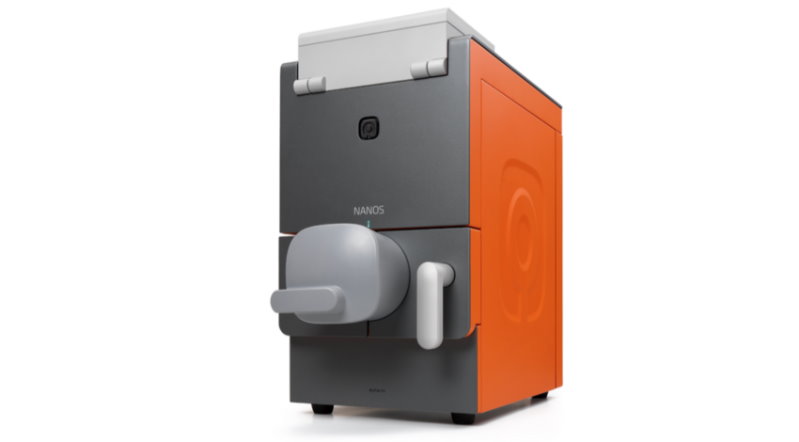
Electron optics rebels come up with new dwarf microscope
They previously caused a furor with the Phenom tabletop microscope. Now these Dutch electron optics experts are launching a small scanning electron microscope that they claim is more user-friendly and also cheaper. The core team of Nuenen-based Phe-nx, maker of the Nanos, consists largely of the people who developed the Phenom and made it a commercial success.
Phenom-World, the maker of the Phenom, was initially set up in a partnership between FEI Electron Optics (now Thermo Fisher Scientific), Philips Natlab, NTS and Sioux. But the devices were so successful that Thermo Fisher Scientific bought the company in early 2018. Phe-nx’s co-founder Karel van der Mast on the birth of the new startup: “It actually started when we realized that Phenom-World wasn’t what it used to be after the acquisition.”

By “we,” Van der Mast is referring to the various other experts on the Phe-nx team. Electron optics is a common thread throughout their careers. The team includes former Phenom-World director Emile Asselbergs and sales manager Richard Geschiere. Another familiar face is Henk Tappel, who is involved as a consultant. In the past, he was a gifted designer at FEI. Then he went on to lead Frencken Mechatronics; now he’s a director at Bronckhorst in Ruurlo. The development team also includes Ton Kluijtmans, a mechanical designer with a Frencken history, and industrial designers Eric Toering and Jasper Pieterse. The latter two previously worked in the startup Controlportals, founded by economist Hans Vriend who has now also joined Phe-nx.
Observant readers will already have noticed that the name of the new Brabant-based technology company sounds like “phoenix,” the mythical bird that rises again and again from its ashes. The “Ph” of Phe-nx is a tribute to Philips, the founder of electron microscopy in Eindhoven; the “e” stands for negatively charged electrons.
Fun
Van der Mast himself has had a handful of careers. Following his studies, he went to work for Philips and, in the Electron Optics activity, was one of the initiators of the merger with the American FEI (Field Electron and Ion Company), an adventure he recounted last year in an interview with High-Tech Systems Magazine (link in Dutch) – the resulting FEI Electron Optics was later acquired by Thermo Fisher. After heading E-lith, a short-lived effort by ASML and Applied Materials to explore electrons for next-generation lithography, he was in charge of strategy, marketing and mergers and acquisitions in Veldhoven, among other things, before joining the Phenom team in 2011.
The Phe-nx co-founder has always enjoyed designing electron optics. It already started during his studies. “Every electron knows where to go, so I thought: it can’t be difficult. And if it’s that easy, then it must be a fun profession,” he recalls.

Car battery
The Phenom’s success was a design that combined good imaging with X-ray analysis capabilities. At a later stage, this SEM also included a field emission source. In contrast, the Nanos has a conventional thermal electron source, basically a filament. “It has a limited lifetime,” Van der Mast acknowledges. “But it’s easy and very cheap to replace.”
While Thermo Fisher Scientific’s tabletop microscopes - there are now over a handful of different versions – carry price tags of around 100,000 euros and higher, you can buy a simple but complete Nanos for well under that amount, with minimal running costs. This makes this SEM an excellent alternative to optical microscopes, which give much less depth of focus. For rapid element analysis, the Nanos is equipped with an energy-dispersive X-ray detector (EDS). All in all, it’s designed for ease of use and easy installation and maintenance.
Phe-nx has already received many interested parties at its office. “You come across the craziest things,” says Van der Mast when asked about the potential customers. “We’ve already had people with samples from glass champagne bottles. They apparently had problems with the glass. We put the shards in our microscope and they were pleased with what they could see.”
Van der Mast cites numerous other parties that have shown interest, such as operators of mines for salt or mineral extraction. “When researching new mines, they bring up drill cores. They cut these into slices and put them under our microscope, and then they immediately know what elements are in the sample.”
Everything is done with ease of use in mind. Van der Mast: “You can connect our Nanos to a car battery. You take it out of the trunk, put a sample in it and you get a result within ten minutes.” He could go on and on with examples: air pollution, paint grains, oil sediments, all can be examined with a Nanos.
New player
Is the Nuenen team hitching a ride on the growing interest in simple, small scanning microscopes? Or is Phe-nx actually vulnerable as a new entrant in a market with more and more suppliers? Alongside established Japanese companies such as JEOL, Hitachi and Thermo Fisher - with a whole family of tabletop SEMs - Coxem has meanwhile launched a series of small microscopes as well. Developed in cooperation with Bruker, one of these, like some Phenom models, is equipped with EDS and electron backscatter diffraction (EBSD). Since 2017, a new American player has also been asserting itself in the tabletop electron microscopy market: NanoImages, a company founded by electron microscopy veterans Jon Lechich and Mike Toalson.
Regardless, Phe-nx has begun its new life. Van der Mast and his co-founders have raised the funds themselves, with some of the employees also investing. “For now, we can do without external backers.”





